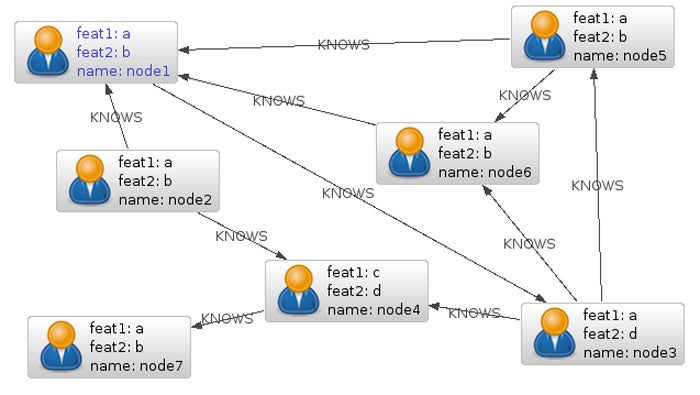Network data models are a way of representing data that can be used for organizing and managing complex relationships between various entities. In some cases, these relationships are as or more important than the data itself—traditional data models fall short when these more expressive use cases arise, but network data models can provide better handling of varying data relationship types. Understanding the principles and mechanics of the network data model as well as its design parameters, benefits, and limitations can give users a powerful tool in their data toolbox.
Table of Contents
How Does a Network Data Model Work?
A network data model is a representation of data that emphasizes the connections and interactions among different entities, providing a dynamic framework for understanding the intricate web of relationships within a system. At its core, a network data model organizes data in a way that reflects the inherent relationships between entities. Unlike the more traditional hierarchical and relational data models, where data is structured in tables or trees, the network model allows for a more flexible and interconnected representation.
Nodes and Edges
The fundamental components of a network data model are nodes and edges. Nodes represent entities, while edges define the relationships or connections between these entities. Each node can have attributes that provide additional information about the entity it represents, and each edge can have properties describing the nature of the relationship.
For example, a social network data model represents individuals as nodes, and connections between them (e.g., friendship, family, professional relationships) are depicted as edges. Each individual node might have attributes like “Name,” “Age,” and “Location,” providing additional details about the person.

Graph Theory Principles
The network data model draws heavily from graph theory, a mathematical discipline that studies the relationships between nodes and edges. Graph theory principles, such as nodes, edges, vertices, and connectivity, form the foundation for constructing and querying data in a network model.
Query Languages
Specialized query languages are often required when interacting with databases that use the network data modeling paradigm. These languages allow users to traverse the graph, retrieve specific information, and perform complex queries that capture the relationships between entities. Common graph query languages include Cypher, Gremlin, and SPARQL, to name a few.
Read Data Modeling vs. Data Architecture to learn more about the distinctions between these two disciplines and understand where they overlap and how each benefits enterprises that use them.
Benefits of a Network Data Model
Network data modeling was created to address the increasing complexities of modern data relationships, providing a more intuitive representation of interconnected information. To this end, organizations that adopt network data modeling stand to realize several benefits.
Flexibility in Data Relationships
A key benefit of the network data model is its flexibility in representing complex relationships. Unlike traditional models that may struggle with many-to-many relationships, the network model excels at capturing intricate connections between entities. This flexibility is particularly valuable in scenarios where relationships are dynamic and evolve over time.
Intuitive Representation
The visual representation of a network data model is often more intuitive for users to understand. With nodes representing entities and edges denoting relationships, the model mirrors real-world connections. This makes it easier for stakeholders, including business analysts and developers, to grasp the structure of the data and how different elements relate to each other.
Efficient Query Performance
The network data model provides more efficient query performance in scenarios where relationships play a crucial role. Traversing relationships in a graph is a natural operation and (in most cases) a trivial affair; the same cannot be said about other types of data model relationships. Graph databases optimized for network models can deliver fast query responses for complex relationship-based queries.
Better Support for Evolving Data Structures
As data requirements evolve, the network data model provides better support for changing structures. Adding or modifying relationships is often more straightforward in a network model than in traditional models, allowing organizations to adapt to new business requirements more seamlessly.
Challenges of Network Data Models
While the network data model offers substantial benefits, it also presents several key challenges that organizations should address prior to adoption:
Complexity in Modeling
Constructing a network data model can be complex, especially when dealing with a large number of entities and intricate relationships. Effective network data model design requires careful consideration of the relationships between nodes, potential redundancy, and the overall structure of the graph.
Performance Scaling
While network data models excel in handling relationships, their performance can degrade when dealing with large datasets or complex graphs. Scaling a network model to accommodate growing amounts of data requires thoughtful database design and optimization strategies to maintain query performance.
Lack of Standardization
Unlike relational databases with their standardized, structured query language (SQL), network databases lack a universally accepted query language. This lack of standardization can pose challenges when working with different graph database systems, as users may need to adapt to the specific query language supported by the chosen database.
Examples of Network Data Models
The following examples are provided to help illustrate how network data models are used in different use cases to showcase how a network data model can effectively capture and represent relationships in diverse domains, from social interactions to complex IT ecosystems.
- Social Network—In social networks, a network data model could represent users as nodes and friendships as edges. Each user node might have attributes like “Username,” “Date of Birth,” and “Location.” The edges would represent the connections between users, indicating the nature of the relationship (e.g., “Friend,” “Follower”).
- IT Infrastructure—In the context of IT infrastructure, a network data model could represent devices (e.g., servers, routers, switches) as nodes and connections between devices as edges. Each device node might have attributes like “IP Address,” “Manufacturer,” and “Operating System.” The edges would represent the physical or logical connections between devices, such as “Connected to” or “Communicates with.”
Bottom Line: Organizing Data With the Network Data Model
The network data model emerged alongside the development of database management systems (DBMS) as an effective way to organize and represent complex data relationships. An improvement over the hierarchical model, it allowed for more flexible relationships between data entities, using a graph-like structure where records could have multiple parent and child nodes. First implemented in pioneering database systems like the Integrated Data Store (IDS), this model facilitated more intricate and interconnected data relationships, offering increased versatility in representing real-world scenarios.
Network data models remain invaluable for organizations grappling with the intricacies of their data relationships and the shortcomings of traditional data models. By emphasizing nodes and edges and drawing inspiration from graph theory, the network data model provides a dynamic and flexible framework for representing interconnected information.
Read Top 7 Data Modeling Tools to learn about the software enterprise teams use to organize and structure their data.



